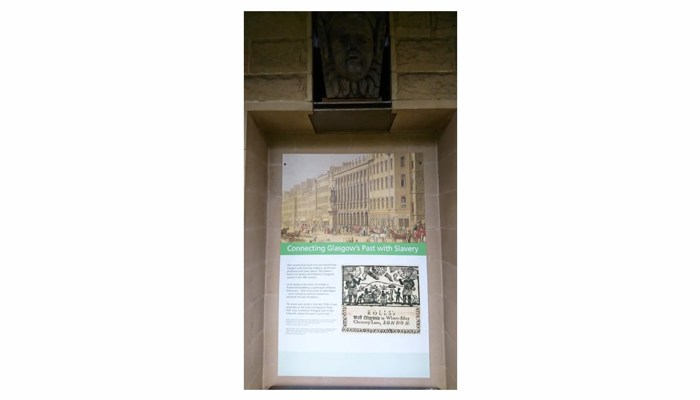
The Tontine Heads
15th August 2018
New interpretation at Provand’s Lordship highlights the links between the ‘Tontine heads’ and slavery. These stone heads were given this name after Glasgow’s Tontine Society took over the Tontine building on Trongate in 1781 to use it as an exchange for sugar dealers. The heads, however, belong to the building when it was Glasgow’s Town Hall.
The Town Hall itself was built between the 1730s and 1750s, with some of the heads dating to the 1750s. They were carved to be keystones for the arches of the piazza facing onto Trongate, designed to inform and entertain in equal measure with the heads representing aspects of city life and interests.
One pair represents the fates of comedy and tragedy, others are green men representing Glasgow’s motto ‘Let Glasgow Flourish’. One head is like an advertising board, giving a message which everyone in eighteenth-century Glasgow would have understood and celebrated – we sell tobacco. Underneath this head is where we have installed a new interpretation panel about slavery.
The head, carved with a feathered headdress, followed the fashion of the time to advertise American tobacco on trade cards using crude caricatured images of Native Americans wearing similar headdresses. Behind them are slaves putting tobacco into hogshead barrels, one sheltering a master with an umbrella. The reference to tobacco being a slave-made product could not be clearer. To illustrate this point, our interpretation uses an image from a trade card in the British Museum’s collection.
This particular card represented Rolls Coffee House in London, well established by the 1730s and continuing to fare well for decades to come. People used it for social and professional meetings. The advertisement’s art was typical of the tobacco and coffee rooms of the period, and Native Americans with feathered headdresses were often seen as symbols of authenticity and quality.
Glasgow’s merchants would have known central London’s coffee houses as well as they knew those of Edinburgh and their native city’s Cockain’s Coffee House. The visual code of slavery was well established and used throughout Great Britain, and adorned the very building where Glasgow Town Council met and did its business.
Dr Anthony Lewis,
Curator of Scottish History

